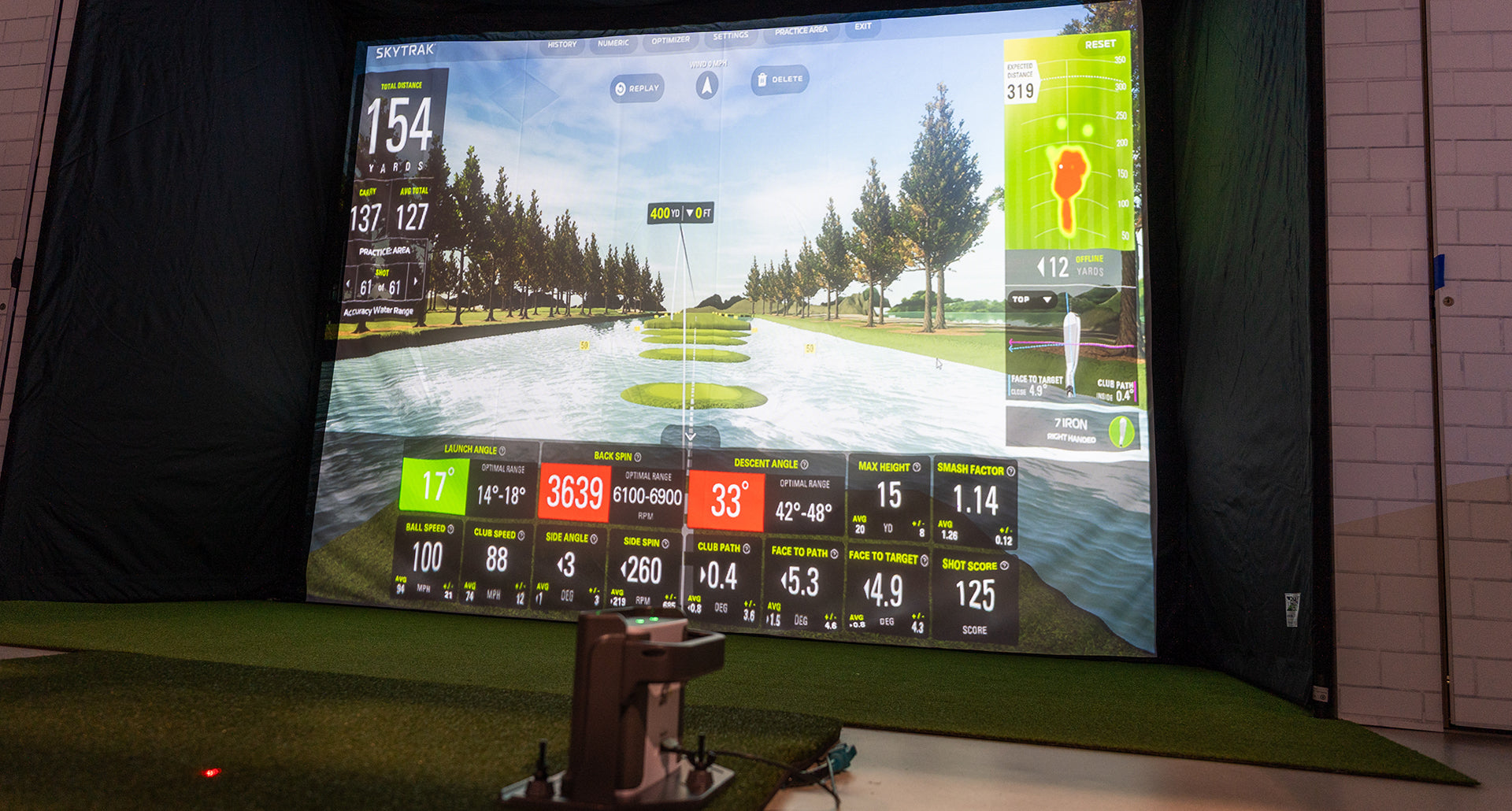
How to Use a Golf Launch Monitor to Improve: Understanding the Data
These days, golf launch monitors offer so much data on your shot—but what are golfers doing with the information? If you have a GLM or are thinking about getting one, let our golf writer Marc help you interpret the numbers to help you play better!
Here's the truth about golf launch monitors: They're incredible if you understand how to interpret the data in a way that can help you improve.
But not every launch monitor owner gets there. For some, of course, the device is strictly for simulator fun and the data means relatively little. Nothing wrong with that. For others, they buy a launch monitor expecting that it will help their game, but they don't really understand the data metrics well enough to gain any insight into their swing.
If you're looking to take things a little further, to go beyond just owning the technology and instead owning something that's closer to a magical device capable of helping you play better golf, then you've arrived at the right spot.
This is a primer for understanding golf launch monitor data. It is written with the intention of helping someone new to launch monitor data make better sense of all of those mysterious numbers and names. After reading this, you should have a solid understanding of how you can use a golf launch monitor to play better golf.
This is not an exhaustive list of data metric explanations. Instead, these are some of the most important and the ones that can benefit the most number of golfers.
This is also not meant to be golf instruction. The tips and descriptions here are meant for you to understand what the various data points mean. As for how you'll use that information to adjust your swing, that's up to you. It's likely that there are quick and easy gains to be made just by better understanding launch monitor data. But it's just as likely that your highest potential won't be unlocked without including some expert instruction in any changes.
What to Look for in a Golf Launch Monitor
What a time to be a golfer! It is absolutely incredible how many great golf launch monitor options are available. Things have exploded in this space in just the past few years. Suddenly, we've got multiple great choices at every price point, including ones that start at less than $1,000.
When choosing a golf launch monitor, you'll of course want to think about what kind of information you want to get out of it as well as how and where you plan to use it. We're going to cover some of the data points in this post, so you'll soon understand that side of the equation better.
For now, just know that there are two general types of data: ball data and club data. Ball data reports what the golf ball itself was doing at and after impact, including how fast it was flying and spinning and in what direction it was heading. Club data reports the facts about the golf swing and what the clubface was doing as it came into the golf ball.
Data metrics are often tied to tiers and subscription fees, so it's important to study which data points you're going to get with each level of each different golf launch monitor. You'll know more about the data you want most in a minute.
As for how and where you're going to use a golf launch monitor, options generally include outdoors at a driving range and indoors in a golf simulator studio. Things like portability, ease of setup, and space requirements become important considerations for each use case.
Some golf launch monitors like the Foresight Sports GC3, GCQuad and QuadMAX sit to the side of the golf ball and don't require nearly as large of a room to play simulator golf indoors. Other options like the FlightScope Mevo Plus, Rapsodo MLM2PRO, and Garmin Approach R10 sit 6 to 8 feet behind the ball and take up more room but have the advantage of not having to be moved if both righty and lefty golfers are playing at the same time.
At PlayBetter.com, we've written space requirement guides for each of the golf launch monitors we sell. And we've compared several of these products head-to-head, scoring their performances in 10 different categories. Find it all on our Golf Blog, and keep up by subscribing to the PlayBetter.com golf email newsletters.
No matter what golf launch monitor you get, you're in for a lot of fun. And you have the chance to use this incredible technology to finally play your best golf.
But first you've got to understand the data.
First Things First: Know Your Carry Distances!
Ask a golfer how far they hit any club, and they'll always answer with what they think is the total distance.
It's like nobody thinks in terms of carry distance.
But if you ask a teaching pro, they're likely to tell you that if you don't know how far you carry each club, then you don't really know your distances. In other words, carry distance is even more important that total distance.
Why?
Because you have to know if you can cover what's in front of you, especially if that includes water or some other area you'd rather not find your golf ball.
The problem for most golfers, and the reason they don't know their carry distances, is because these are very difficult numbers to get — unless you have a golf launch monitor! Normally, you're not going to know exactly where the ball landed, unless it's on a green where you can see a ball mark. So it's difficult to get that data without a radar or camera-based system.
If you only used your golf launch monitor to really dial in and totally know your carry distances, it'd be money well spent. This can have a huge impact on your ability to choose the right club and to stop coming up short or bouncing through the green.
Also, while not every golf launch monitor will give you your total distances, those are of course important numbers to know as well. Just understand that varying ground conditions make it harder for a golf launch monitor to accurately simulate total distance numbers. Yet another reason to focus on carry distance on your golf launch monitor.
If You Want to Hit It Further, You've Got to Hit It Faster: Ball Speed, Clubhead Speed, and Swing Speed
When it comes to speed, almost every golf launch monitor gives us two key pieces of data: ball speed and clubhead speed.
As you might have guessed, ball speed is the measurement of how fast the ball is moving after it comes off the clubface. While clubhead speed, or swing speed, is how fast the head of the golf club is swinging. Both are measured on your golf launch monitor in miles per hour.
These are the two biggest factors for increasing distance. So if you want to hit it further, these are two numbers you'll study regularly.
But to really achieve your maximum distances, you'll need an efficient swing that makes contact with the ball in the center of the clubface. That's why ball speed is generally the better number to track. You can swing harder and increase your clubhead speed but still hit the ball poorly and suffer even shorter distances. But it's hard to increase your ball speed without making flush contact.
How Launch Angle and Angle of Attack Impact Distance and Ball Flight
The angle at which the golf ball ascends after impact is called launch angle or vertical launch. And it's another one of the key metrics for any golfer to maximize their distance.
If you're launching the ball too high or low, launch angle along with angle of attack (the angle at which the ball is coming into the club) are to blame. This is another area where launch monitors can become really useful. And it can even be a lot of fun experimenting with the different swing feels associated with the different launch angle numbers you get.
Angle of attack is measured on a golf launch monitor as either positive or negative. With a driver, where we want to hit the ball with an ascending blow, we'd hope to see a positive angle of attack. With a short iron where we may want to come in from a steeper angle, hitting down on the ball, the angle of attack number is going to be negative.
Angle of attack along with the loft of your golf club and your ball position will directly impact launch angle. Understanding these numbers is one of the keys to finding your ideal ball flight, and a golf launch monitor can help you get there much faster than if you just relied on your naked eye at the driving range.
Simplifying Spin Rates
Distance, speed, and maybe even launch angle and angle of attack, are relatively straightforward concepts for most golfers to grasp. But spin rates can be a bit, well, dizzying.
First, the reason they're important: It's good to know how much spin you're putting on the golf ball because it directly impacts distance, height, direction, and roll out.
Like with all data, different golf launch monitors will deliver different spin metrics. These are the common ones:
Back spin: The rate at which the golf ball rotates backward after it leaves the clubface.
Side spin: The rate at which the golf ball rotates along its horizontal axis, moving either right or left, after it's struck.
Spin rate: A comprehensive metric that quantifies the total rotation of the ball per minute. This is the most important spin number for you to know.
Spin axis: This metric integrates both back and side spin to indicate the ball's directional tendency post-impact, with leftward movement marked as negative and rightward as positive.
Spin loft: Represents the angular difference between the angle of attack and the dynamic loft of the club. A greater spin loft generally increases spin while reducing distance, whereas a lower spin loft helps to maximize distance by reducing spin.
If you want to pick one spin number to learn and learn well, make it spin rate. Here's a rule of thumb: Your spin rate should be approximately 1,000 times greater than the number of the club you're hitting. So an 8 iron might produce a spin rate in the neighborhood of 8,000. If your numbers are way off of that general rule, you may want to investigate what's causing that.
Your Clubface Determines Your Launch Direction
The direction your golf ball is going relative to your target line immediately after the strike is the launch direction. It's measured in degrees.
And the single biggest cause for whether the ball is going left, right, or straight is your clubface angle, which is also measured in degrees. If the clubface is open, for a right-handed golfer, the ball will start to the right. Closed and it's heading left.
In which direction the ball curves after its initial launch direction has to do with spin numbers.
To play great golf, you have to learn to control the clubface. In other words, you have to be able to reliably start the ball on the line that you're intending. It's the first key to establishing a repeatable ball flight. And this is another area where a launch monitor can give you incredible feedback to help you understand quickly exactly what you might be doing wrong. If we see, for example, that the clubface was 2 degrees open at impact, we can more specifically work to change why the ball keeps shooting off to the right.
Understanding the Relationship Between Club Face and Club Path
As discussed, your clubface angle shows whether your clubface was opened, closed, or square with your target. And your club path angle is the direction that the club is swinging relative to the target line at the moment of impact.
When we put clubface and club path together, we get what's commonly referred to as face to path. It's the difference between the face angle and the club path and is also reported in degrees. If the face-to-path number is positive, it means the clubface was pointing to the right of the club path. A negative number means the clubface was pointing left of the path.
This, coupled with launch angle, is how spin is imparted on the golf ball and it helps us understand why the ball is curving in a certain direction.
The holy grail to mastering ball flight is to ideally marry the face angle and club path. The correct golf swing isn't a certain amount of in-to-out or out-to-in. Rather, it all depends on what that path is relative to what the clubface angle is.
Not every golf launch monitor will give you a face-to-path reading. But if you do have this information, study it carefully and start to learn how the different angle intersections produce different ball flights.
Smash Factor Is a Good Overall Number to Study
Smash factor tells you how efficiently you're making contact. It is calculated by dividing ball speed by clubhead speed. One simple way to think of it is how close to really flushing it you came.
The higher the smash factor number, the better. It means you've more efficiently transferred more energy from the golf club to the golf ball. And it probably means the ball is going to fly further.
With a 7 iron, you're likely to see smash factor numbers between 1.3 and 1.4. And with a driver, it might bump up to somewhere in the neighborhood of 1.4 to 1.52.
If you're seeing improved smash factor numbers on your golf launch monitor, there's a very good chance you're seeing better performance out on the golf course.
But don't fall too in love with any one data point. Even smash factor is not the whole picture. To really get the most out of your golf launch monitor and game improvement, you need to understand several different metrics.
Use Your Golf Launch Monitor to Your Advantage
Different launch monitors provide different data points. Depending on what you get, you may have an array of metrics even beyond the ones we've covered here. But these are some of the most important. Each of them are good numbers to understand clearly so that you can interpret your golf launch monitor data and put it to game-improvement use.
Another important point to keep in mind is that golf launch monitor accuracy will vary. While it's not an absolute rule, generally speaking, the less expensive golf launch monitors are not going to be quite as pinpoint accurate as their more expensive counterparts. Spin rates are one area where lesser units report the most inaccuracies.
Then again, even very affordable golf launch monitors should be able to accurately report some of the most critical numbers like carry distance.
So consider how seriously you want to take your practice and how important absolute accuracy is. For many of us, "good enough" is good enough. But for others, the margins are much tighter.
We've arrived at a point in time where if you're not using a golf launch monitor to better understand your golf swing, you're really not giving yourself the best chance to play your best. These are incredible devices. They are amazing for entertainment as golf simulators, but they are just as powerful as the impartial judges of exactly what we're doing in our golf swings.
And now you should have a better understanding of how to use the information that golf launch monitors give you.
About PlayBetter Golf Reviewer Marc Sheforgen
Marc "Shef" Sheforgen is a golf writer whose passion for the game far exceeds his ability to play it well. Marc covers all things golf, from product reviews and equipment recommendations to event coverage and tournament analysis. When he's not playing, watching, or writing about golf, he enjoys traveling (often golf-related), youth sports coaching, volunteering, and record collecting.




